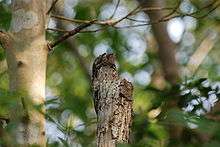Common potoo
| Common potoo | |
|---|---|
 | |
| Well-camouflaged on a broken branch Common Potoo song, recorded in Colombia | |
| Scientific classification | |
| Kingdom: | Animalia |
| Phylum: | Chordata |
| Class: | Aves |
| Subclass: | Neornithes |
| Infraclass: | Neognathae |
| (unranked): | Cypselomorphae |
| Order: | Caprimulgiformes |
| Family: | Nyctibiidae |
| Genus: | Nyctibius |
| Species: | N. griseus |
| Binomial name | |
| Nyctibius griseus (Gmelin, 1789) | |
The common potoo, grey potoo, lesser potoo or poor-me-one (Nyctibius griseus), is a nocturnal bird which breeds in tropical Central and South America from Nicaragua to northern Argentina and northern Uruguay. The northern potoo (N. jamaicensis) was formerly classified as a subspecies of this species.
This potoo is a large cypselomorph bird related to the nightjars and frogmouths, but like other potoos it lacks the bristles around the mouth found in the true nightjars. It is 33–38 cm long and pale greyish to brown, finely patterned with black and buff, camouflaged to look like a log; this is a safety measure to help protect it from predators, but its mode of perch is also a camouflage. It has large orange eyes.
The common potoo can be located at night by the reflection of light from its eyes as it sits on a post, or by its haunting melancholic song, a BO-OU, BO-ou, bo-ou, bo-ou, bo-ou, bo-ou, bo-ou, bo-ou dropping in both pitch and volume.It has special disruptive coloration so it camouflages into a branch, as shown on the picture.[3]
It is a resident breeder in open woodlands and savannah. It avoids cooler montane regions, rarely occurring over 1,900 meters ASL even in the hottest parts of its range. Also, arid regions are usually avoided; for example in the dry Caribbean plain of Colombia the species was first recorded in April 1999. In gallery forest-type environment around the Uruguayan-Brazilian border, it is by no means uncommon. A bit further south, where the amount of wood- versus grassland is somewhat lower, it is decidedly rare, and due west, in the Entre Ríos Province of Argentina with its abundant riparian forest it is likewise not common. The birds at the southern end of their range may migrate short distances northwards in winter.[4]
This nocturnal insectivore hunts from a perch like a shrike or flycatcher. During the day it perches upright on a tree stump, and is completely invisible, looking like part of the stump because it stays so completely still as it perches. If disturbed by larger animals, such as common marmosets (Callithrix jacchus), it may break its camouflage and try to chase them away however.[5]
The single egg is white with lilac spots.[6] It is laid directly in a depression in a tree limb,[7] usually some meters above ground. It is not clear whether there can be, on occasion, two eggs in a clutch.[8]
This widespread species is not considered threatened by the IUCN.[9]
Footnotes
- ↑ BirdLife International (2012). "Nyctibius griseus". IUCN Red List of Threatened Species. Version 2013.2. International Union for Conservation of Nature. Retrieved 26 November 2013.
- ↑ Cestari, C; Guaraldo, AC; Gussoni, COA (2010). "Nestling Behavior and Parental Care of the Common Potoo (Nyctibius griseus) in Southeastern Brazil". The Wilson Journal of Ornithology. 123 (1): 102–6. doi:10.1676/10-087.1.
- ↑ Cott, Hugh (1940). Adaptive Coloration in Animals. Oxford University Press. pp. 352–353.
- ↑ Cuervo et al. (2003), Strewe & Navarro (2004), Azpiroz & Menéndez (2008)
- ↑ de Lyra-Neves et al. (2007)
- ↑ Hilty, Steven L.; Brown, Bill (1986). A Guide to the Birds of Colombia. Princeton, NJ, US: Princeton University Press. p. 235. ISBN 978-0-691-08372-8.
- ↑ E.g. of Cecropia: Greeney et al. (2004)
- ↑ Greeney et al. (2004)
- ↑ BLI (2008)
References
- Azpiroz, Adrián B. & Menéndez, José L. (2008): Three new species and novel distributional data for birds in Uruguay. Bull. B.O.C. 128(1): 38-56.
- Cuervo, Andrés M.; Stiles, F. Gary; Cadena, Carlos Daniel; Toro, Juan Lázaro & Londoño, Gustavo A. (2003): New and noteworthy bird records from the northern sector of the Western Andes of Colombia. Bull. B. O. C. 123(1): 7-24. PDF fulltext
- de Lyra-Neves, Rachel M.; Oliveira, Maria A.B.; Telino-Júnior,Wallace R. & dos Santos, Ednilza M. (2007): Comportamentos interespecíficos entre Callithrix jacchus (Linnaeus) (Primates, Callitrichidae) e algumas aves de Mata Atlântica, Pernambuco, Brasil [Interspecific behaviour between Callithrix jacchus (Linnaeus) (Callitrichidae, Primates) and some birds of the Atlantic forest, Pernanbuco State, Brazil]. Revista Brasileira de Zoologia 24(3): 709–716 [Portuguese with English abstract]. doi:10.1590/S0101-81752007000300022 PDF fulltext.
- Greeney, Harold F.; Gelis, Rudolphe A. & White, Richard (2004): Notes on breeding birds from an Ecuadorian lowland forest. Bull. B.O.C. 124(1): 28-37. PDF fulltext
- Strewe, Ralf & Navarro, Cristobal (2004): New and noteworthy records of birds from the Sierra Nevada de Santa Marta region, north-eastern Colombia. Bull. B.O.C. 124(1): 38-51.
Further reading
- ffrench, Richard; O'Neill, John Patton & Eckelberry, Don R. (1991): A guide to the birds of Trinidad and Tobago (2nd edition). Comstock Publishing, Ithaca, N.Y.. ISBN 0-8014-9792-2
- Hilty, Steven L. (2003): Birds of Venezuela. Christopher Helm, London. ISBN 0-7136-6418-5
External links
- Common potoo videos, photos & sounds on the Internet Bird Collection
- "Common potoo" photo gallery VIREO
